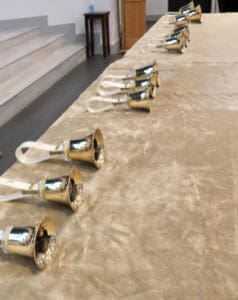
Hear Ye! Hear Ye! We are looking for handbell ringers to participate in this unique music ministry.
You do not need the ability to read music to join our St. Faustina group, which is a welcome addition to all our special liturgies. The only qualification to become a bell ringer is the willingness to learn and have a GREAT TIME!
Our Handbell Choir debuted at our Christmas Eve 9:00 pm Christmas Carol presentation (scroll down and click on the YouTube video to see one of their songs). What a great way to kick-off this ministry…and we invite you to join it!!
The Handbell Choir practices on Wednesday nights from
7:15 p.m. to 8:30 p.m.
If you are interested or would like more information, please contact our Director of Liturgy and Music, Kelly Mucci, at kmucci@stfaustina.org or call her at 352-515-9297.
Hand-held bells have a long history, dating to between 1696 and 1724. Margaret Shurclfiff was the first to take handbells to the United States from England in 1902. Arthur Hughes, the general manager of the Whitechapel Bell Foundry, gave Shurcliff the set of 10 handbells in London in 1902.
 The bells used in American handbell choirs are almost always English handbells. “English handbells” refers to a specific type of handbells, not their country of origin. While some American handbell choirs use bells made in England, the majority play bells made either by Malmark Bellcraftsmen or by Schulmerich, both based in Pennsylvania
The bells used in American handbell choirs are almost always English handbells. “English handbells” refers to a specific type of handbells, not their country of origin. While some American handbell choirs use bells made in England, the majority play bells made either by Malmark Bellcraftsmen or by Schulmerich, both based in Pennsylvania
A handbell choir or ensemble (in the United States) or handbell team (in England) is a group that rings recognizable music with melodies and harmony.
 The bells are typically arranged chromatically on foam-covered tables; these tables protect the bronze surface of the bell and keep the bells from rolling when placed on their sides. Unlike an orchestra or choir in which each musician is responsible for one line of the texture, a handbell ensemble acts as one instrument, with each musician responsible for particular notes, sounding their assigned bells whenever those notes appear in the music.
The bells are typically arranged chromatically on foam-covered tables; these tables protect the bronze surface of the bell and keep the bells from rolling when placed on their sides. Unlike an orchestra or choir in which each musician is responsible for one line of the texture, a handbell ensemble acts as one instrument, with each musician responsible for particular notes, sounding their assigned bells whenever those notes appear in the music.
A ringer rings the handbell by moving it in such a way that the clapper strikes the inside surface of the bell, usually holding it against his or her shoulder, bell upwards, and then swinging the bell through an elliptical shape to cause the clapper to strike the casting. The tone of the bell will continue to resonate, decaying naturally until it stops completely or the ringer stops it by damping the bell with a hand or on the body or a padded surface.
If you would like to learn more about this unique brand of music, please go to: Handbell – Wikipedia


